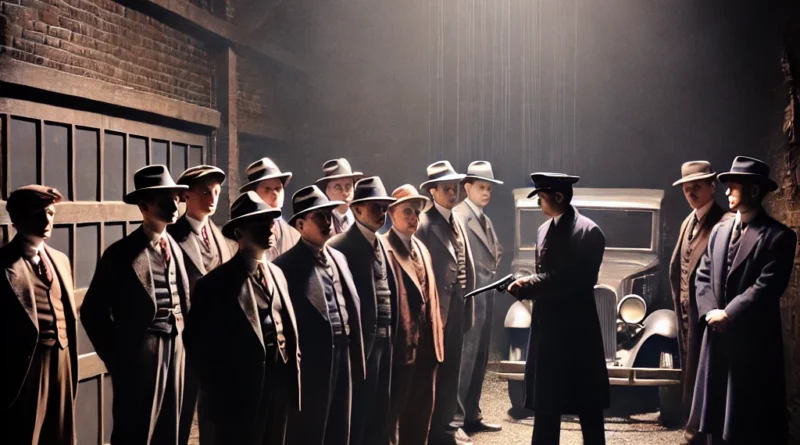Saint Valentine’s Day Massacre in Chicago Illinois
The Saint Valentine’s Day Massacre stands as one of the most infamous events in American crime history. Occurring on February 14, 1929, in Chicago, Illinois, this brutal act of gang violence was a decisive moment in the Prohibition era, demonstrating the ruthless nature of organized crime. The massacre saw seven men affiliated with the North Side Gang, led by George “Bugs” Moran, executed in cold blood inside a garage at 2122 North Clark Street.
This massacre was widely believed to be orchestrated by the powerful gangster Al Capone, whose Chicago Outfit sought complete control over the city’s illegal bootlegging operations. The attack, which involved gunmen disguised as police officers, sent shockwaves across the country and marked a turning point in the fight against organized crime.
The Saint Valentine’s Day Massacre remains a chilling chapter in American history, highlighting the extreme measures gangsters were willing to take to secure dominance. This article delves into the background, execution, aftermath, and legacy of this horrific crime.
Background: The Rise of Chicago’s Gang Wars
During the 1920s, Prohibition fueled an underground economy driven by illegal liquor sales. Criminal organizations, led by figures like Al Capone and Bugs Moran, fought for control over this lucrative trade.
Chicago became a battleground where rival gangs constantly clashed over territory and supply routes. The North Side Gang, originally formed by Dean O’Banion, had long been in conflict with Capone’s Chicago Outfit. When O’Banion was assassinated in 1924, Moran and others took over leadership, continuing the feud against Capone.
Capone, operating from his headquarters in Cicero, Illinois, was determined to eliminate his enemies. The Saint Valentine’s Day Massacre was a calculated strike designed to cripple Moran’s operations once and for all.
The Events Leading Up to the Massacre
In early 1929, tensions between the North Side Gang and Capone’s organization reached a boiling point. Moran’s gang was still a formidable force, controlling much of the bootlegging in the city. Capone, who was in Florida at the time, allegedly orchestrated the attack through his top enforcer, Jack “Machine Gun” McGurn.
The plan was simple yet ruthless: lure Moran’s men to a garage under the pretense of a major whiskey shipment and eliminate them. The location was the S.M.C. Cartage Company garage at 2122 North Clark Street, a known headquarters for Moran’s operations.
Capone’s men devised a scheme to disguise themselves as Chicago police officers, a tactic that would make the victims believe they were being raided. This deception allowed the gunmen to catch their targets off guard, preventing any resistance.
The Massacre: February 14, 1929
On the morning of February 14, 1929, members of the North Side Gang gathered at the Clark Street garage to await the delivery of contraband liquor. Moran himself was running late, which inadvertently saved his life. As he approached the garage, he noticed police officers nearby and decided to turn away.
Inside, however, seven of his men were not as fortunate. The victims included:
- Peter Gusenberg – Enforcer
- Frank Gusenberg – Enforcer
- Albert Kachellek (James Clark) – Moran’s second-in-command
- Adam Heyer – Business manager
- Albert Weinshank – Associated with Moran’s operations
- Reinhardt Schwimmer – A former optometrist with ties to the gang
- John May – An occasional mechanic
As the men waited, two individuals dressed as police officers entered the garage, accompanied by two more armed men in civilian clothes. The victims were lined up against a brick wall, convinced they were being arrested.
Suddenly, the attackers opened fire with Thompson submachine guns, unleashing a storm of bullets. The massacre lasted only a few minutes but left all seven victims riddled with gunfire. The killers then staged a fake police arrest, leading the civilian-dressed gunmen out of the garage to avoid suspicion.
Immediate Aftermath and Investigation
The carnage was discovered shortly after the gunmen fled. When real police arrived, they found a horrific scene: bodies lay sprawled across the floor, blood pooling around them.
Miraculously, Frank Gusenberg was still alive despite suffering over 14 gunshot wounds. When questioned by police, he refused to name his attackers, famously stating, “Nobody shot me.” He died a short time later at the hospital.
The authorities launched an extensive investigation, but evidence was scarce. The killers had executed their plan flawlessly, leaving behind few leads. The use of police disguises made it difficult to determine who was involved.
Al Capone’s Role and Lack of Convictions
Despite widespread belief that Al Capone ordered the massacre, no direct evidence ever linked him to the crime. At the time, Capone was conveniently in Florida, providing him with an alibi.
Investigators suspected Jack McGurn, a known Capone enforcer, but he also escaped prosecution due to lack of witnesses willing to testify. Fred “Killer” Burke, another prime suspect, was later arrested in Michigan for an unrelated murder, but he was never charged for the massacre itself.
Impact on Public Perception of Organized Crime
The Saint Valentine’s Day Massacre shocked the nation, drawing widespread media attention. The brutality of the killings exposed the extent of organized crime’s control over Chicago, forcing law enforcement to take a harder stance against gangsters.
This event marked a turning point in how the federal government addressed organized crime. President Herbert Hoover ordered law enforcement to aggressively pursue Capone, leading to his eventual conviction on tax evasion in 1931.
Legacy of the Massacre
Though Capone’s power waned after his imprisonment, the Saint Valentine’s Day Massacre left an indelible mark on American history. The garage where the killings took place was later demolished in 1967, and its bricks were preserved as a macabre reminder of the violent Prohibition era.
The event continues to captivate historians and crime enthusiasts, inspiring numerous books, documentaries, and films. The Mob Museum in Las Vegas now houses part of the original brick wall, offering visitors a glimpse into this dark moment in Chicago’s past.
Conclusion
The Saint Valentine’s Day Massacre remains one of the most infamous gangland killings in American history. It was a defining moment in the Chicago gang wars, highlighting the extreme lengths gangsters were willing to go to maintain control.
While the true masterminds behind the massacre were never officially convicted, the event played a critical role in the downfall of Al Capone and the growing federal crackdown on organized crime.
Today, the massacre serves as a haunting reminder of the violent past of the Prohibition era, an era where crime and corruption flourished in the shadows of America’s major cities.
Discover more from City Towner
Subscribe to get the latest posts sent to your email.




